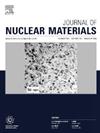A new approach to investigate secondary hydriding phenomenon on M5Framatome clads under high–temperature LOCA conditions
IF 2.8
2区 工程技术
Q3 MATERIALS SCIENCE, MULTIDISCIPLINARY
引用次数: 0
Abstract
The focus of this study is about a new experimental approach for a separate effects study of the secondary hydriding phenomenon under LOCA conditions. Many nuclear institutes perform semi–integrals tests to study the cladding behaviour during a LOCA transient. Those tests combined several phenomena and performing a detailed analysis of the secondary hydriding phenomenon using these tests can be challenging. A dedicated experimental protocol aiming at simulating secondary hydriding has been set up. Separate effects tests (SETs) were then carried out using this protocol to study the effects of both oxidation duration and temperature, on the hydrogen absorption during the oxidation stage of the LOCA transient on M5Framatome1 cladding. The effects of gap size were also investigated. Metallographic analysis has been used to characterise the M5Framatome clad metallurgical transformation after the high–temperature (HT) oxidation.
研究高温 LOCA 条件下 M5Framatome 堆焊体二次水化现象的新方法
本研究的重点是采用一种新的实验方法,对 LOCA 条件下的二次水化现象进行单独效应研究。许多核研究所都会进行半积分试验,以研究 LOCA 瞬态期间的包壳行为。这些试验结合了多种现象,利用这些试验对二次水化现象进行详细分析具有挑战性。我们制定了一个专门的实验方案,旨在模拟二次水化。然后,利用该方案进行了单独效应试验 (SET),以研究氧化持续时间和温度对 M5Framatome1 包层 LOCA 瞬态氧化阶段吸氢的影响。此外,还研究了间隙大小的影响。金相分析用于描述高温(HT)氧化后 M5Framatome 熔覆层的冶金转变特征。
本文章由计算机程序翻译,如有差异,请以英文原文为准。
求助全文
约1分钟内获得全文
求助全文
来源期刊

Journal of Nuclear Materials
工程技术-材料科学:综合
CiteScore
5.70
自引率
25.80%
发文量
601
审稿时长
63 days
期刊介绍:
The Journal of Nuclear Materials publishes high quality papers in materials research for nuclear applications, primarily fission reactors, fusion reactors, and similar environments including radiation areas of charged particle accelerators. Both original research and critical review papers covering experimental, theoretical, and computational aspects of either fundamental or applied nature are welcome.
The breadth of the field is such that a wide range of processes and properties in the field of materials science and engineering is of interest to the readership, spanning atom-scale processes, microstructures, thermodynamics, mechanical properties, physical properties, and corrosion, for example.
Topics covered by JNM
Fission reactor materials, including fuels, cladding, core structures, pressure vessels, coolant interactions with materials, moderator and control components, fission product behavior.
Materials aspects of the entire fuel cycle.
Materials aspects of the actinides and their compounds.
Performance of nuclear waste materials; materials aspects of the immobilization of wastes.
Fusion reactor materials, including first walls, blankets, insulators and magnets.
Neutron and charged particle radiation effects in materials, including defects, transmutations, microstructures, phase changes and macroscopic properties.
Interaction of plasmas, ion beams, electron beams and electromagnetic radiation with materials relevant to nuclear systems.
 求助内容:
求助内容: 应助结果提醒方式:
应助结果提醒方式:


